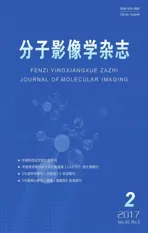不同年龄儿童中腺病毒所致喘息性支气管炎分析
2017-07-03纪国业林冬云朱冬卉廖永华
纪国业,林冬云,朱冬卉,廖永华
广州医科大学附属第六医院//清远市人民医院儿科,广东 清远 511500
不同年龄儿童中腺病毒所致喘息性支气管炎分析
纪国业,林冬云,朱冬卉,廖永华
广州医科大学附属第六医院//清远市人民医院儿科,广东 清远 511500
目的通过分析儿童各年龄段喘息性支气管炎中腺病毒感染所致的比例特点,指导临床诊治。方法收集1132例于2014年1月~2016年7月在清远市人民医院儿科门急诊就诊或住院部治疗,临床并结合胸片结果诊断为喘息性支气管炎的儿童,依据年龄分为5组:<6个月组、≥6个月且<1岁组、≥1岁且<3岁组、≥3岁且<6岁组、≥6岁且<14岁组,分别根据呼吸道病毒检测结果,记录各组腺病毒阳性例数,计算腺病毒感染率并予统计分析。结果各组腺病毒感染率差异有统计学意义,以≥6岁且<14岁组腺病毒感染率最高(38.2%,χ2=35.216,P=0.000)。结论腺病毒感染所致儿童喘息性支气管炎在≥6岁且<14岁年龄段所占喘息性支气管炎比例最高,临床中应引起重视。
腺病毒;儿童;喘息性支气管炎;年龄
喘息性支气管炎在各年龄段儿童中均可发病,临床表现为低到中度发热,呼气时间延长、伴有哮鸣音及粗湿啰音;与过敏、感染等因素有关,部分病例可发展为支气管哮喘,与儿童哮喘恶化密切相关[1]。多种病原体,如病毒、细菌、支原体等感染均可引起。其中,作为导致儿童喘息性支气管炎其中的一种重要病原体,腺病毒在临床中逐渐被重视[2-3]。腺病毒共有42个血清型,免疫功能低下、特应性体质、营养障碍、佝偻病和支气管结构异常均为其感染的危险因素[4]。然而,随着儿童各年龄段生理等各方面因素的差异,腺病毒感染所致喘息性支气管炎是否也存在年龄差异?各年龄段喘息性支气管炎腺病毒感染比例是否不同?目前国内外文献尚未有相关报道,也是临床医生迫切需解决的问题。
1 资料与方法
1.1 研究对象
收集2014年1月~2016年7月期间,年龄≥28 d且<14岁,症状以喘息为主,体查双肺可闻及明显哮鸣音,经胸片证实为支气管炎,且在本院儿科门急诊就诊或住院部治疗,经临床医生明确诊断为喘息性支气管炎患儿。所有患儿均行呼吸道病毒7项检测、血清降钙素原浓度及痰培养检测。
1.2 分组
根据儿童喘息性支气管炎发病特点[5],按照年龄共分为5组:<6个月组、≥6个月且<1岁组、≥1岁且<3岁组、≥3岁且<6岁组、≥6岁且<14岁组。共1132例符合条件患儿。
1.3 试剂
呼吸道病毒检测(鼻咽拭子定性检测),呼吸道7项试剂盒(免疫荧光法),采用日本尼康E100荧光显微镜检测。检测项目有常见呼吸道病毒:腺病毒、甲型流感病毒、乙型流感病毒、副流感病毒1型、副流感病毒2型、副流感病毒3型、呼吸道合胞病毒。降钙素原检测 ,降钙素原检测试剂盒(电化学发光法)(厂家:上海罗氏诊断产品有限公司,产品编号:YZB/GER 1542-2015,规格:100测试/盒)。细菌培养基,由广州迪景公司提供,鉴定仪器为法国梅里埃公司的ATB细菌鉴定仪。
1.4 结果观察
根据分组及咽拭子呼吸道病毒7项结果,分别统计各组腺病毒阳性例数并计算腺病毒阳性率。为排除混合感染干扰,如果患儿腺病毒结果阳性,同时又有其他呼吸道病毒阳性或者痰培养阳性、降钙素原明显升高(≥0.5 μg/mL),则不列入统计范围。
1.5 统计学处理
利用SPSS17.0软件,采用R×C表资料卡方分析方法比较各组腺病毒感染率差异,P<0.05为差异有统计学意义。
2 结果
5组不同年龄段腺病毒感染率有显著性差异。其中以≥6岁且<14岁组腺病毒感染率最高(38.2%),<6个月组腺病毒感染率最低(14.0%),差异具有统计学意义(χ2=35.216,P=0.000,表1,图1)。

表1 不同年龄组儿童喘息性支气管炎腺病毒感染率比较(n=1132,α=0.05)
3 讨论
喘息性疾病是小儿常见性疾病,严重喘息可导致呼吸衰竭。而呼吸道病毒是诱发喘息发作的主要因素[6]。而引起儿童喘息性支气管炎的呼吸道病毒已证明有呼吸道合胞病毒、鼻病毒、副流感病毒、腺病毒等[7-8]。目前,国内外鲜有腺病毒所致儿童喘息性支气管炎年龄特点的报道。
本研究中结果显示,在腺病毒感染所致儿童喘息性支气管炎年龄分布中,≥6岁且<14岁年龄段,即年长儿中腺病毒感染率最高(38.2%),越往小年龄组统计,腺病毒感染所致喘息性支气管炎比例越低。其原因可能与低年龄儿童,特别是引起婴幼儿(3岁以下)喘息性支气管炎最主要为呼吸道合胞病毒有关[9],其次为人偏肺病毒、鼻病毒[10]等,而腺病毒仅为较次要病原体,这与Heymann[11]及Turunen[12]等报道一致。一方面,随着年龄增长,呼吸道合胞病毒感染明显减少;腺病毒随年龄增长而下呼吸道感染率相对下降幅度小,从而导致腺病毒感染所致喘息性支气管炎比例相对增多;另一方面,有国外学者指出,3~18岁儿童所发生喘息性疾病中,特应性体质具有重要的影响因素[9],该类年长儿往往具有气道高反应性[13]、特异性IgE致敏[14]、湿疹[15]、家族遗传史倾向[16-17],说明年长儿发生喘息性支气管炎可能是腺病毒与过敏、免疫因素相互作用所致。
从总体上看,腺病毒致喘息性支气管炎从绝对数量上仍以低年龄段儿童(3岁以下)为主,且最低年龄组(<6个月)腺病毒感染率为14.0%,这与Maffey等[5]所报道的小年龄段喘息性支气管炎儿童腺病毒感染所占比例仅为3%不同,说明腺病毒仍为导致低年龄段(<3岁)儿童发生喘息性支气管炎重要的病原体之一[18-19];这一现象也符合呼吸道病毒致儿童下呼吸道感染好发于婴幼儿的年龄分布规律[20]。
综上所述,在儿童喘息性支气管炎中,≥6岁且<14岁(年长儿)年龄段腺病毒感染率最高;故在临床工作中,应对此年龄段儿童较其他年龄儿童更应重点考虑腺病毒感染所致喘息性支气管炎,从而及早做出临床应对策略。这或应引起临床儿科工作者的重视。
[1]Johnston SL, Pattemore PK, Sanderson G, et al. Community study of role of viral infections in exacerbations of asthma in 9-to 11-year-old children[J]. BMJ, 1995, 310(6989): 1225-9.
[2]杨曼琼, 黄 寒, 肖霓光. 小儿喘息性疾病喘息反复发作的病原学及危险因素分析[J]. 现代生物医学进展, 2013, 5(24): 4742-5.
[3]García-García ML, Calvo C, Falcón A, et al. Role of emerging respiratory viruses in children with severe acute wheezing[J]. Pediatr Pulmonol, 2010, 45(6): 585-91.
[4]王卫平, 毛 萌, 李廷玉, 等. 儿科学[M].8版. 北京: 人民卫生出版社, 2013: 268-9.
[5]Maffey AF, Venialgo CM, Barrero PR, et al. New respiratory viruses in children 2 months to 3 years old with recurrent wheeze[J]. Arch Argent Pediatr, 2008, 106(4): 302-9.
[6]Gern JE, Busse WW. The role of viral infections in the natural history of asthma[J]. J Allergy Clin Immunol, 2000, 106(2): 201-12.
[7]Camara AA, Silva JM, Ferriani VP, et al. Risk factors for wheezing in a subtropical environment: role of respiratory viruses and allergen sensitization[J]. J Allergy Clin Immunol, 2004, 113(3): 551-7.
[8]Chen HL, Chiou SS, Hsiao HP, et al. Respiratory adenoviral infections in children: a study of hospitalized cases in southern Taiwan in 2001--2002[J]. J Trop Pediatr, 2004, 50(5): 279-84.
[9]Rakes GP, Arruda E, Ingram JM, et al. Rhinovirus and respiratory syncytial virus in wheezing children requiring emergency care[J].Am J Respir Crit Care Med, 1999, 159(3): 785-90.
[10]Jackson DJ, Evans MD, Gangnon RE, et al. Evidence for a causal relationship between allergic sensitization and rhinovirus wheezing in early Life[J]. Am J Respir Crit Care Med, 2012, 185(3): 281-5.
[11]Heymann PW, Carper HT, Murphy DD, et al. Viral infections in relation to age, atopy, and season of admission among children hospitalized for wheezing[J]. J Allergy Clin Immunol, 2004,114(2): 239-47.
[12]Turunen R, Koistinen A, Vuorinen T, et al. The first wheezing episode: respiratory virus etiology, atopic characteristics, and illness severity[J]. Pediatr Allergy Immunol, 2014, 25(8): 796-803.
[13]李成瑶, 付 娟, 陈 虹. 小儿喘息性疾病病因及流行病学分析[J].中国妇幼保健, 2012, 27(23): 3601-4.
[14]Lukkarinen M, Lukkarinen H, Lehtinen P, et al. Prednisolone reduces recurrent wheezing after first rhinovirus wheeze: a 7-year follow-up[J]. Pediatr Allergy Immunol, 2013, 24(3): 237-43.
[15]Jartti T, Kuusipalo H, Vuorinen T, et al. Allergic sensitization is associated with rhinovirus-, but not other virus-, induced wheezing in children[J]. Pediatr Allergy Immunol, 2010, 21(7): 1008-14.
[16]Graham LM. Preschool wheeze prognosis: how do we predict outcome?[J]. Paediatr Respir Rev, 2006, 7(Suppl 1): S115-6.
[17]Carroll KN, Gebretsadik T, Minton P, et al. Influence of maternal asthma on the cause and severity of infant acute respiratory tract infections[J]. J Allergy Clin Immunol, 2012, 129(5): 1236-42.
[18]Viegas M, Barrero PR, Maffey AF, et al. Respiratory viruses seasonality in children under five years of age in Buenos Aires,Argentina: a five-year analysis[J]. J Infect, 2004, 49(3): 222-8.
[19]Videla C, Carballal G, Misirlian A, et al. Acute lower respiratory infections due to respiratory syncytial virus and adenovirus among hospitalized children from Argentina[J]. Clin Diagn Virol, 1998,10(1): 17-23.
[20]中华医学会儿科学分会呼吸学组, <中华儿科杂志>编辑委员会.儿童社区获得性肺炎管理指南(2013年修订版)[J] .中华儿科杂志,2013, 51(10): 745-52.
Asthmatic bronchitis induced by adenovirus in children of different ages
JI Guoye, LIN Dongyun, ZHU Donghui, LIAO Yonghua
Department of Pediatrics, Qingyuan People' Hospital, the Sixth Affiliated Hospital of Guangzhou Medical university, Qingyuan 511500,China
ObjectiveTo analyze the characteristics of the proportion of the adenovirus infection in children with asthmatic bronchitis in different ages, and to guide the clinical diagnosis and treatment.MethodsA total of 1132 cases from January 2014 to July 2016 in Qingyuan City People's Hospital pediatrics outpatient and emergency department or hospital treatment were chosed, with clinical and chest X-ray diagnosis for children of asthmatic bronchitis. According to ages,they were divided into 5 groups (<6 months, ≥6 months and <1 year old, ≥1 year old and <3 years old, ≥3 years of age and <6 years old, ≥6 years old and <14 years old), respectively according to the detection of respiratory viruses and they were recorded each adenovirus positive cases, calculate the positive rate of adenovirus and were given statistical analysis.ResultsSignificant differences were found in the positive rate of each group of adenovirus. Adenovirus positive rate in group of ≥6 years old and <14 years old was the highest (x2=35.216, P=0.000).ConclusionThe highest proportion of the adenovirus infection in children with asthmatic bronchitis were in the ages of ≥6 years old and <14 years old group (elder age group), which in clinical diagnosis should be paid attention.
adenovirus; children; asthmatic bronchitis; age
2017-01-12
纪国业,硕士,E-mail: jgyut@163.com;
